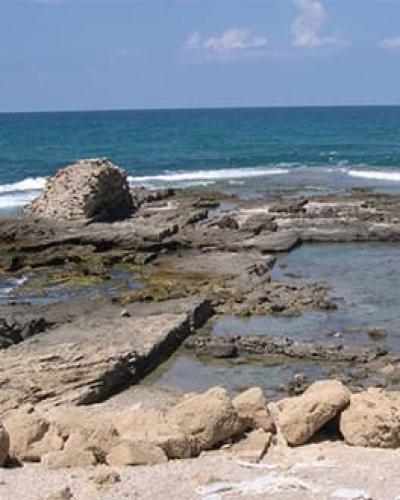According to Josephus, Herod the Great built a splendid palace as a showpiece of his new city and Sebastos, its great artificial harbor. That city, Caesarea Maritima, established on the site of the Hellenistic city of Strato's Tower, is the setting for numerous historical events and personages.
Our work at Caesarea focused largely on archaeological excavation, but we studied elements of landscape and architectural design as well--and this aspect of our work is important as we try to understand Caesarea as not only an ancient site, but also an example of political power and a meeting place of Eastern and Western design. Students excavated the site scientifically and then explored the palace through graphic reconstruction and interpretation.
The ruins of Caesarea Maritima lie forty kilometers north of Tel Aviv along the rapidly developing coastline, divided among the lands of the Israel National Park Authority, Kibbutz Sdot Yam, and the development projects of the privately owned Caesarea Development Corporation. The Promontory Palace, extending westwards 100 m. into the sea, is situated within the National Park, adjacent to the restored ancient theater and the newly discovered amphitheatron (a stadium/hippodrome complex).
The ruins of the palace lie in two parts. The Lower Palace is built close to sea level, its central peristyle framing a great rock-cut pool. The Upper Palace, built on a higher reach of the promontory and on a slightly different orientation, focuses on a large central courtyard, paved in compacted crushed stone. Although not previously well-known to tourists, the promontory palace is currently undergoing partial reconstruction as part of a tourist path from the theater to a new seaside promenade terminating at the Crusader Fortress wall.
Caesarea Maritima, established by Herod the Great on the site of the Hellenistic city of Strato's Tower, has been known continuously from its founding through until the present day, and is the setting for numerous historically significant events and personages. The palace of the city is mentioned in only a few instances, although incidents in lives of the procurators, governors and other officials who dwelt there are more frequently described.
The basileia features prominently in Josephus' description of Herod's building programs at Caesarea. Agrippa I was struck by fatal illness in the theater and died in the palace. "Herod's praetorium" was the destination of the apostle Paul for a hearing before Antoninus Felix at Caesarea (Acts of the Apostles 23:35.). Later, Herod Agrippa II and his sister Berenike visited a new governor, Porcius Festus,there and heard Paul's self-defense in the akroaterion (Acts 25:23). Josephus, in relating the incident of the standards at Caesarea (BellJ 2 169-74; AntJ 18.57), mentions a demonstration outside of the palace which moved into the adjacent stadium.
Together these narrative sources provide an image of the palace, stadium (amphitheater, hippodrome), and theater in close proximity to one another. Such a constellation of palace and public buildings in the southern area of the city, however, was unknown to excavators until the last quarter of this century. Only the theater, excavated in 1958 by A. Frova had been recognized since the mapping efforts of Conder and Kitchener in the 1880s. The palace and Josephus' amphiteatron, however, remained lost to memory.


